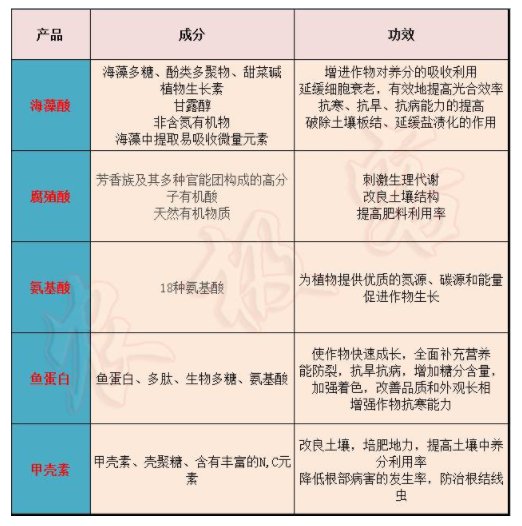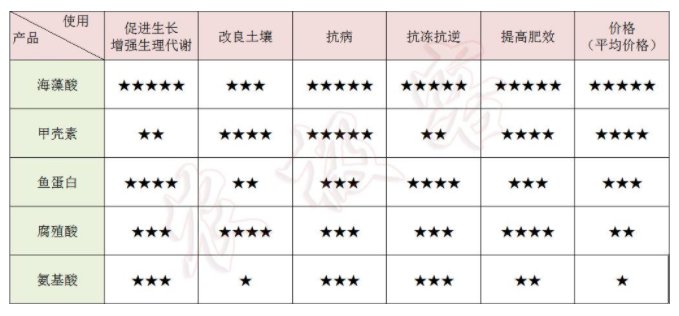1. Fish protein, amino acids
Fish protein is to degrade the protein into low molecular peptides and amino acids after the low-value fish and shrimp grains are crushed or ground, and the protein is degraded into low-molecular-weight peptides and amino acids by the decomposition and digestion of its own enzymes or microorganisms. In fact, fish protein is a macromolecule of amino acids, and after fish protein is decomposed, amino acids are formed.
Amino acid is a general term for a class of organic compounds containing amino and carboxyl groups. Animal hair and other animal protein, fermentation industrial wastewater. The basic unit of biological function macromolecular protein is the basic substance that constitutes the protein required for animal and plant nutrition. It is an organic compound containing basic amino groups and acidic carboxyl groups. It is a group of organic compounds with different molecular weights, containing amino and carboxyl groups, and a short carbon chain.
Amino acids are an important part of soil organic nitrogen and an important nutrient source for soil microorganisms. Soil microorganisms can use amino acids as precursors in the metabolic process to synthesize plant growth regulators through biological pathways to stimulate plant growth and regulate plant physiological processes. . At present, the amino acids on the market are manufactured by chemical methods such as hydrochloric acid and sulfuric acid, which will destroy the types of amino acids. At the same time, there may be residues of hydrochloric acid and sulfuric acid. Therefore, the biological fermentation method produces a rich variety of amino acids with less residues, while fish protein It is a good amino acid product.
Amino acids are one of the more important nutrient elements in the growth process of crops, which are of great help to the photosynthetic respiration of plants, and can increase the content of chlorophyll and improve the quality of crops.
The compound amino acid foliar fertilizer is absorbed by the crops through the leaves, stems or roots of the crops, and has obvious effects on the rooting, germination, seedlings, flowers, fruits and fruit preservation of crops, and can stimulate the activity of enzymes, improve photosynthetic efficiency, accelerate Nutrient absorption and operation, increase chlorophyll content, increase dry matter accumulation and sugar content, improve crop quality, enhance crop drought resistance, disease resistance, stress resistance and immunity, etc.
The role and advantages of amino acid foliar fertilizer:
1. Amino acids exist in fertilizers as the smallest molecule that constitutes protein, and have the characteristics of being easily absorbed by crops; they also have the function of improving disease resistance of fertilized objects and improving the quality of fertilized crops.
2. Supplement the essential amino acids of plants, stimulate and regulate the rapid growth of plants, promote the robust growth of plants, and promote the absorption of nutrients. Enhance the metabolic function of plants, improve photosynthesis, promote the development of plant roots, and accelerate plant growth and reproduction.
2, humic acid:
Humic acid is widely found in soil, lakes, rivers, oceans, and peat (also known as peat), lignite, and weathered coal. A class of complex natural organic matter accumulated during geochemical reactions and accumulation.
Most humic acids on the market contain fulvic acid, black humic acid and brown humic acid. Among them, fulvic acid has a regulating effect and belongs to a class of growth regulators, which can promote plant growth and control the stomatal expansion of crops. Moreover, fulvic acid + potassium oxide can be made into potassium fulvic acid.
The most prominent role of humic acid is the improvement of soil and the transformation of nutrient elements, so that plants can better absorb nutrients.
The function of humic acid in plant protection
1. Improve the defense of plants against natural disasters.
After the use of humic acid, the root system is particularly developed, the biochemical effect of chlorophyll is strengthened, the metabolism is prosperous, and the disease resistance is strong; it is very obvious in the recovery of drought, waterlogging and freezing disasters. The humic acid solution is sprayed, and the plant scratches are repaired quickly, avoiding fruit drop due to bacterial infection.
2, fertilization and disease prevention.
Humic acid not only has high physiological activity, but also contains special live bacteria. Humic acid has a strong hygroscopic function, adjusts the structure and diversity of soil microorganisms, inhibits indigenous pathogenic bacteria in soil, and enhances crop availability. transsexual. The earlier application of biological humic acid is conducive to the timely ecological adjustment of soil microorganisms, changes soil compaction, and has more obvious fertilizer and control effects.
3. The treatment of humic acid from mineral sources to diseased and weak fruit trees.
Due to the rapid application of chemical fertilizers, pesticides and hormones, as well as the improper use of chemical fertilizers, resulting in fat injury, fruit trees appear premature aging or even withering of orchards, which is called "chemical pesticide syndrome". Concentrated liquid fertilizer with humic acid, combined with the application of organic fertilizer, loosening the soil and cutting off roots, appropriate pruning and other agricultural measures can be completely rejuvenated.
4. Spray the foliage of crops.
Foliar spraying of humic acid has obvious effects on crop "tonic" and disease prevention and yield increase. This is the advantage of biological humic acid. Now many fruit trees use fruit bagging. If humic acid liquid fertilizer is sprayed before bagging, the fruit will grow. Very plump, bright in appearance and sweeter in taste, it is a genuine green food.
5. Overcome the obstacles of greenhouse serialization.
The obstacle to continuous cropping in greenhouses is that after multi-season farming, the microbiome and fertilizer factors in the soil environment in the greenhouse make crops unable to grow normally, and continuous cropping is hindered. The use of humic acid can restore the biodiversity of the cultivated soil in the greenhouse and form a good ecological environment.
Similarities and differences between amino acid foliar fertilizer and humic acid
[Essential distinction]: Amino acids are substances that make up the plant itself, which can be directly absorbed and involved in the metabolism of the plant and transformed into what the plant needs most. And humic acid is to promote the synthesis of the most needed things after absorption.
[Type distinction]: Amino acid foliar fertilizer, organic-inorganic composite (chelate) type water-soluble fertilizer, trace element sequestration production process, the higher the chelation value, the better the crop absorption and utilization rate.
Humic acid foliar fertilizer, organic-inorganic compound (chelate) type water-soluble fertilizer, is beneficial to the phenomenon of soil compaction and fertility decline caused by long-term use of chemical fertilizers in farmland, and the increase of top-dressing fertilizer but the phenomenon that the yield does not go up all the time is more beneficial, and can be adjusted quickly. The soil structure loosens the soil so that the nutrients in the soil can be better absorbed by plants.
[Characteristics distinction]: Amino acid foliar fertilizers are nitrogen-containing fatty acids with small molecular weights. Humic acid foliar fertilizer is macromolecular aromatic organic carboxylic acid.
[Functional distinction]: The biggest feature of amino acid foliar fertilizer is that it can significantly improve the nutrients applied by top dressing, which can be better and faster absorbed and transformed and utilized. Significantly improved.
Humic acid foliar fertilizer can quickly and effectively activate the soil, effectively adjust the pH of the soil, and balance the pH. It is a non-polluting green ecological fertilizer.
3. Alginic acid
Alginic acid contains a variety of plant growth regulators, mainly to promote cell division and promote plant growth, strengthen the metabolism of plants and make plants grow.
Using seaweed as raw material, the seaweed cells are broken through technical means, the content is released, and then concentrated to form seaweed essence concentrate, which greatly retains the natural active ingredients of seaweed, and is a new type of fertilizer with high efficiency and low cost.
The characteristics of seaweed fertilizer are as follows:
1. Rich in nutrients
Active seaweed fertilizer contains a large amount of non-nitrogen-containing organic matter, more than 40 kinds of minerals and rich vitamins such as potassium, calcium, magnesium, iron, zinc, iodine, etc., which are unmatched by terrestrial plants, especially the unique seaweed polysaccharides in seaweed, Alginic acid, highly unsaturated fatty acids and various natural plant growth regulators can stimulate the production of non-specific active factors in plants and regulate the balance of endogenous hormones.
2. Easy to be absorbed by plants
After special treatment, the active ingredients in seaweed fertilizer are in an active state that is easily absorbed by plants. They enter the plant body 2 to 3 hours after application, and have a fast absorption and conduction speed. The alginic acid in the seaweed fertilizer can reduce the surface tension of the water, form a film on the surface of the plant, increase the contact area, and the water-soluble substances can easily penetrate the surface cells of the stems and leaves, so that the plants can effectively absorb the nutrients in the seaweed extract Element.
3. It can improve the soil
Seaweed fertilizer is a natural biological system that works in harmony with the plant-soil ecosystem. It can add organic matter directly to the soil or through plants, and activate various microorganisms in the soil. These microorganisms can act as catalysts in the plant-microbial metabolite cycle, increasing soil bioavailability.
4. Long-lasting fertilizer effect
Seaweed fertilizer can directly increase soil organic matter or increase soil organic matter through plants, activate various beneficial microorganisms in soil, and these microorganisms can play a catalytic role in the cycle of plant-microbial metabolites and increase the biological effectiveness of soil. Metabolites from plants and soil microorganisms can provide plants with more nutrients. At the same time, the chelation system formed by seaweed polysaccharide and humic acid can release nutrients slowly and prolong the fertilizer effect.
5. Safe and non-toxic
Natural seaweed has good affinity with terrestrial plants, is non-toxic and harmless to humans and animals, and has no pollution to the environment. It is a high-quality fertilizer for the production of harmless vegetables.
1. Select humic acid for soil compaction. Humic acid can well improve the soil compaction, acidification, and fertility decline caused by long-term use of chemical fertilizers. Spraying humic acid foliar fertilizer two to three times can have obvious effects.
2. Select amino acids for crops lacking nutrients. It is a good choice to spray foliar fertilizers containing amino acids in the middle and late stages of crops, which can promote the better and more comprehensive absorption of nutrients, thereby increasing production and income.
3. Pure humic acid and alginic acid both promote plant growth through the environment or by regulating a certain link of plant metabolism. The fish protein and amino acids are directly absorbed by crops to form the body structure. For example, a plant is like a car processing plant, and our goal is to make the processing plant produce more. The use of amino acids and fish protein for plants is equivalent to providing wheels and engines for automobile processing plants, eliminating the need for factories to process rubber into wheels, while the use of humic acid and seaweed fertilizer is equivalent to teaching workers to improve their work efficiency.
Note: The effect of humic acid and alginic acid alone is not good, and it needs to be applied in combination with other fertilizers.
4、Chitin:
Also known as chitin, chitin, shell protein, crab chitin, etc., it is widely found in lower animals, especially the shells of arthropods (such as insects, spiders, crustaceans, etc.) and lower plants (such as fungi, algae, In the cell wall of yeast, etc.), it is a natural biopolymer and is a linear polysaccharide.

